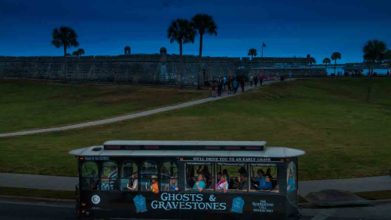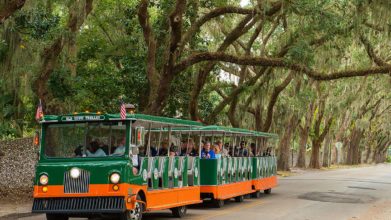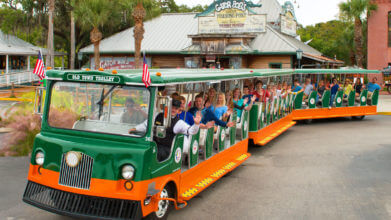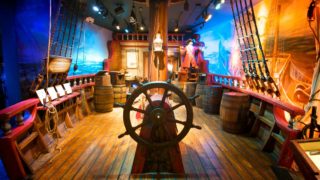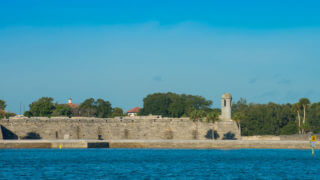Fun Facts About St. Augustine
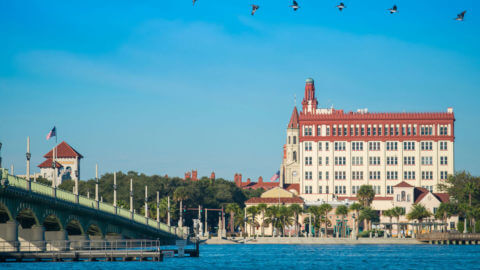
St. Augustine Facts
Since its founding in September 1565, St. Augustine has managed to intrigue and entertain visitors for more than 450 years. As the oldest continuously occupied European-established settlement in the continental United States, the Nation’s Oldest City offers more than charming brick-lined streets, historical landmarks and pristine beaches. It’s also a wealth of interesting stories and historical tidbits. To help make your upcoming trip to St. Augustine just that much better, we’ve compiled a list of the top fun facts about this beautiful city by the sea.
Relive history and enjoy Transportainment®
Located on the western short of Matanzas Bay, Castillo de San Marcos (known simply as “The Fort” to locals) is the oldest masonry fort in the continental United States.
The famous Bridge of Lions, a double-leaf bascule bridge that spans the Intra-coastal Waterway connecting Anastasia Island to downtown, features a pair of Medici lions made of Carrara marble.
A popular tourist destination, the Lightner Museum is housed in the former health facilities of the Hotel Alcazar including the spa and Turkish bath.
The original Ripley’s Believe It Or Not! museum in St. Augustine is 20,000 square feet and features 19 themed galleries and more than 300 exhibits and artifacts across three floors.
Ponce de Leon’s Fountain of Youth has guest books stretching back to 1868.
The St. Augustine Distillery, which handcrafts small-batch rum, vodka and gin, is also home to Florida’s first large-format bourbon currently aging in oak barrels.
The city plays backdrop to one of the world’s most amazing displays of holiday lights. Each year, the historic district is lit up with nearly two million sparkling white lights.
The St. Augustine Lighthouse, built in 1874, is one of the city’s most recognizable landmarks. At 165 feet tall, the lighthouse is a welcoming array of black and white stripes with red detailing.
The St. Augustine Alligator Farm and Zoological Park, founded in 1893, is the only facility in the world exhibiting living examples of all 23 currently recognized species of crocodilian.
In September 2015, the city of St. Augustine celebrated its 450th birthday over a five-day celebration of music, food, dance and libations.
St. Augustine is home to the narrowest street in the country. At just seven feet wide, Treasury Street connects the waterfront Bay Street to the Royal Spanish Treasury.
Featuring a few hundred wax sculptures of famous politicians, historical personalities, sports stars and celebrities, Potter’s Wax Museum is the oldest wax museum in the United States.
The Cathedral Basilica, located downtown on Cathedral Place, is home to the first Catholic congregation in North America.
Not far from the city gate, the Oldest Wooden School House is touted as being the oldest wooden school building in the country. Though the exact date of construction is unknown, it first appears on tax records as early as 1716.
Over the years, many notable residents have called St. Augustine home including musician Ray Charles, novelist Zora Neale Hurston and human rights activist Stetson Kennedy.
Built in 1883 as home to Franklin W. Smith, an eccentric Boston millionaire,Villa Zorayda (also known as the Zorayda Castle) was inspired by the 12th century Moorish Alhambra Palace in Spain.
Renovated in 2007, the St. Augustine Amphitheater, a 4,000-seat outdoor concert venue, regularly hosts some of the biggest names in music including James Taylor, Jack Johnson and Aretha Franklin.
Anastasia State Park, located on a peninsula on the Atlantic coast of Anastasia Island, is a 1,600 acre Florida State Park housing a variety of wildlife, tidal salt marsh and marine hammock.
St. Augustine has repeatedly been named among the most haunted cities in America with ghost stories spanning some four-and-a-half centuries.
Located on San Marco Avenue, the historic Old Jail was built by Henry Flagler in 1891 and served as the St. Johns’ County jail until 1953.
In the 1880s and beyond, American industrialist Henry Flagler was the driving force behind turning St. Augustine into a winter resort for the wealthy northern elite.
Founded in 1968, Flagler College is a private, four-year liberal arts college housed in the Ponce de Leon Hotel, a luxury hotel built in 1888.
Relocated from Key West in December 2010, St. Augustine Pirate & Treasure Museum on South Castillo Drive is home to one of only three remaining authentic Jolly Roger flags in the world.
St. Augustine is also referred to as “Ancient City,” “Old City” and the “Nation’s Oldest City.”
Housed in one of Henry Flagler’s old East Coast Railway buildings in downtown St. Augustine, the San Sebastian Winery has an overall production of over one million bottles.

